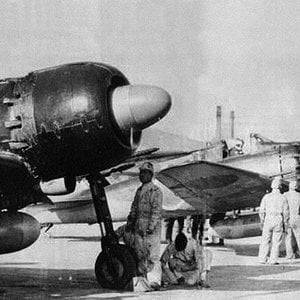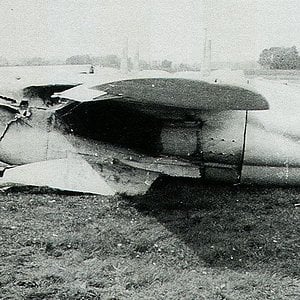Navigation
Install the app
How to install the app on iOS
Follow along with the video below to see how to install our site as a web app on your home screen.
Note: This feature may not be available in some browsers.
More options
You are using an out of date browser. It may not display this or other websites correctly.
You should upgrade or use an alternative browser.
You should upgrade or use an alternative browser.
Development
Kurt Tank's team at Focke-Wulf had been working for some time on a fast attack bomber aircraft called the Ta 211, so named because it planned to use an uprated Jumo 211R engine. The plane was a high-wing twin-engine design that bore a strong resemblance to the Grumman F7F Tigercat, and was built primarily of plywood bonded with a special phenolic resin adhesive called Tego film.[1] The only large-scale use of metal was in the pressurized cockpit.
The project's designation was changed to Reichsluftfahrtministerium (RLM—Ministry of Aviation) assignment number 8-154 (hence Ta 154) when it became apparent that the most suitable engine for the aircraft was the more powerful Jumo 213, and that Junkers could not deliver the Jumo 211-R in time due to technical and production problems. The 154 was also allocated the name "Moskito" as a form of recognition of the Royal Air Force's (RAF) de Havilland Mosquito.
In August 1942, the RLM asked for designs to meet a need for a dedicated night fighter, and the competition quickly boiled down to the Heinkel He 219 and the Ta 154. 15 prototypes of each were ordered for further testing. Throughout the contest the RLM generally favored the 219 due to its better visibility and range. They also seemed to be suspicious of the 154's wooden construction. In 1942, the Messerschmitt Me 210 should have been the only plane considered, but it was suffering significant development problems and was ignored.
It was at about this time that the light and very fast de Havilland Mosquito, also made of wood, arrived over Germany. It quickly racked up an impressive record; in its first 600 bombing missions, only one was shot down, compared to an average of 5%[2] for RAF medium and heavy bombers. Erhard Milch personally requested a purpose-built German answer, and selected the 154. Infighting within German circles started almost immediately, because the RLM and night fighter units still wanted the He 219. Milch took this personally, and spent the better part of the next two years trying to have the 219 program terminated.
[edit] Flight tests
Development of the Ta 154 was already well advanced, and the first prototype V1 with Jumo 211F engines. bearing the Stammkennzeichen identification code TE+FE, had its maiden flight on July 1, 1943. It was followed by V2 with Jumo 211N engines, which was kept at the factory for handling trials. V1 was then sent to Rechlin-Lärz Airfield for fly-off testing against the He 219A and the new Junkers Ju 388. There the 154 reached almost 700 km/h (440 mph) and easily outflew the other two planes, but those were both fully armed and equipped with radar.
The first armed example of the Ta 154 was the V3 prototype, which also was the first to fit the Jumo 211R engines. The added weight of the guns and drag of the 32-dipole element Matratze radar antennas used on its UHF-band FuG 212 Lichtenstein C-1 radar unit slowed the plane by a full 75 km/h, although it was still somewhat faster than the 219. The rest of the 15 prototypes were then delivered as A-0 models, identical to V3. Some of these also included a raised canopy for better vision to the rear.
It quickly became clear that the Jumo 211R would not be available any time soon, if at all. Future production turned to the more powerful Jumo 213A, but this was also suffering from long delays. The 154 program spent most of the next year testing various prototypes, and sent many of the A-0s to Erprobungskommando 154. During these tests the plane showed an alarming tendency to break its complex lever-action landing gear, and about half of the V series were lost this way.
By June 1944, the Jumo 213 was finally arriving in some numbers, and a production run of 154 A-1s were completed with these engines. Just prior to delivery[citation needed] the only factory making Tego-Film, in Wuppertal, was bombed out by the Royal Air Force, and the plywood glue had to be replaced by one that was not as strong, and was later found to react chemically, apparently in a corrosive manner, with the wood in the Ta 154's structure. In July, several A-1s crashed with wing failure due to plywood delamination. This same problem also critically affected the Heinkel He 162 Spatz, Ernst Heinkel's "Volksjäger" jet fighter program entry.
Tank halted production in August, and the RLM eventually cancelled the entire project in September (Milch had been removed by then). At that time about 50 production aircraft had been completed, and a number of the A-0 pre-production planes were later modified to the production standard. Some of the planes served with Nachtjagdgeschwader 3[quantify], and a few were later used as training aircraft for jet pilots.
The designation A-2/U3 was given to six A-0s converted into Mistel composite aircraft.
[edit] Specifications (Ta 154 A-1)
Data from[citation needed]
General characteristics
Crew: 2
Length: 12.55 m (40 ft 3¼ in)
Wingspan: 16.30 m (52 ft 5¼ in)
Height: 3.60 m (11 ft 4 in)
Wing area: 31.40 m² (333.7 ft²)
Empty weight: 6,600 kg (15,000 lb)
Max. takeoff weight: 9,950 kg (21,900 lb)
Powerplant: 2 × Junkers Jumo 211N liquid-cooled V12 engine, 1,450 PS (1,066 kW) each
Performance
Maximum speed: 615 km/h (332 kn, 382 mph)
Range: 1,400 km (760 nmi, 870 mi)
Service ceiling: 9,500 m (31,000 ft)
Rate of climb: 15 m/s (2,800 ft/min)
Armament
2 × 20 mm MG 151 cannons
2 × 30 mm (1.18 in) nose-mounted MK 108 cannons
2 × fuselage-mounted 30 mm (1.18 in) MK 108 cannons, Schräge Musik
Kurt Tank's team at Focke-Wulf had been working for some time on a fast attack bomber aircraft called the Ta 211, so named because it planned to use an uprated Jumo 211R engine. The plane was a high-wing twin-engine design that bore a strong resemblance to the Grumman F7F Tigercat, and was built primarily of plywood bonded with a special phenolic resin adhesive called Tego film.[1] The only large-scale use of metal was in the pressurized cockpit.
The project's designation was changed to Reichsluftfahrtministerium (RLM—Ministry of Aviation) assignment number 8-154 (hence Ta 154) when it became apparent that the most suitable engine for the aircraft was the more powerful Jumo 213, and that Junkers could not deliver the Jumo 211-R in time due to technical and production problems. The 154 was also allocated the name "Moskito" as a form of recognition of the Royal Air Force's (RAF) de Havilland Mosquito.
In August 1942, the RLM asked for designs to meet a need for a dedicated night fighter, and the competition quickly boiled down to the Heinkel He 219 and the Ta 154. 15 prototypes of each were ordered for further testing. Throughout the contest the RLM generally favored the 219 due to its better visibility and range. They also seemed to be suspicious of the 154's wooden construction. In 1942, the Messerschmitt Me 210 should have been the only plane considered, but it was suffering significant development problems and was ignored.
It was at about this time that the light and very fast de Havilland Mosquito, also made of wood, arrived over Germany. It quickly racked up an impressive record; in its first 600 bombing missions, only one was shot down, compared to an average of 5%[2] for RAF medium and heavy bombers. Erhard Milch personally requested a purpose-built German answer, and selected the 154. Infighting within German circles started almost immediately, because the RLM and night fighter units still wanted the He 219. Milch took this personally, and spent the better part of the next two years trying to have the 219 program terminated.
[edit] Flight tests
Development of the Ta 154 was already well advanced, and the first prototype V1 with Jumo 211F engines. bearing the Stammkennzeichen identification code TE+FE, had its maiden flight on July 1, 1943. It was followed by V2 with Jumo 211N engines, which was kept at the factory for handling trials. V1 was then sent to Rechlin-Lärz Airfield for fly-off testing against the He 219A and the new Junkers Ju 388. There the 154 reached almost 700 km/h (440 mph) and easily outflew the other two planes, but those were both fully armed and equipped with radar.
The first armed example of the Ta 154 was the V3 prototype, which also was the first to fit the Jumo 211R engines. The added weight of the guns and drag of the 32-dipole element Matratze radar antennas used on its UHF-band FuG 212 Lichtenstein C-1 radar unit slowed the plane by a full 75 km/h, although it was still somewhat faster than the 219. The rest of the 15 prototypes were then delivered as A-0 models, identical to V3. Some of these also included a raised canopy for better vision to the rear.
It quickly became clear that the Jumo 211R would not be available any time soon, if at all. Future production turned to the more powerful Jumo 213A, but this was also suffering from long delays. The 154 program spent most of the next year testing various prototypes, and sent many of the A-0s to Erprobungskommando 154. During these tests the plane showed an alarming tendency to break its complex lever-action landing gear, and about half of the V series were lost this way.
By June 1944, the Jumo 213 was finally arriving in some numbers, and a production run of 154 A-1s were completed with these engines. Just prior to delivery[citation needed] the only factory making Tego-Film, in Wuppertal, was bombed out by the Royal Air Force, and the plywood glue had to be replaced by one that was not as strong, and was later found to react chemically, apparently in a corrosive manner, with the wood in the Ta 154's structure. In July, several A-1s crashed with wing failure due to plywood delamination. This same problem also critically affected the Heinkel He 162 Spatz, Ernst Heinkel's "Volksjäger" jet fighter program entry.
Tank halted production in August, and the RLM eventually cancelled the entire project in September (Milch had been removed by then). At that time about 50 production aircraft had been completed, and a number of the A-0 pre-production planes were later modified to the production standard. Some of the planes served with Nachtjagdgeschwader 3[quantify], and a few were later used as training aircraft for jet pilots.
The designation A-2/U3 was given to six A-0s converted into Mistel composite aircraft.
[edit] Specifications (Ta 154 A-1)
Data from[citation needed]
General characteristics
Crew: 2
Length: 12.55 m (40 ft 3¼ in)
Wingspan: 16.30 m (52 ft 5¼ in)
Height: 3.60 m (11 ft 4 in)
Wing area: 31.40 m² (333.7 ft²)
Empty weight: 6,600 kg (15,000 lb)
Max. takeoff weight: 9,950 kg (21,900 lb)
Powerplant: 2 × Junkers Jumo 211N liquid-cooled V12 engine, 1,450 PS (1,066 kW) each
Performance
Maximum speed: 615 km/h (332 kn, 382 mph)
Range: 1,400 km (760 nmi, 870 mi)
Service ceiling: 9,500 m (31,000 ft)
Rate of climb: 15 m/s (2,800 ft/min)
Armament
2 × 20 mm MG 151 cannons
2 × 30 mm (1.18 in) nose-mounted MK 108 cannons
2 × fuselage-mounted 30 mm (1.18 in) MK 108 cannons, Schräge Musik








